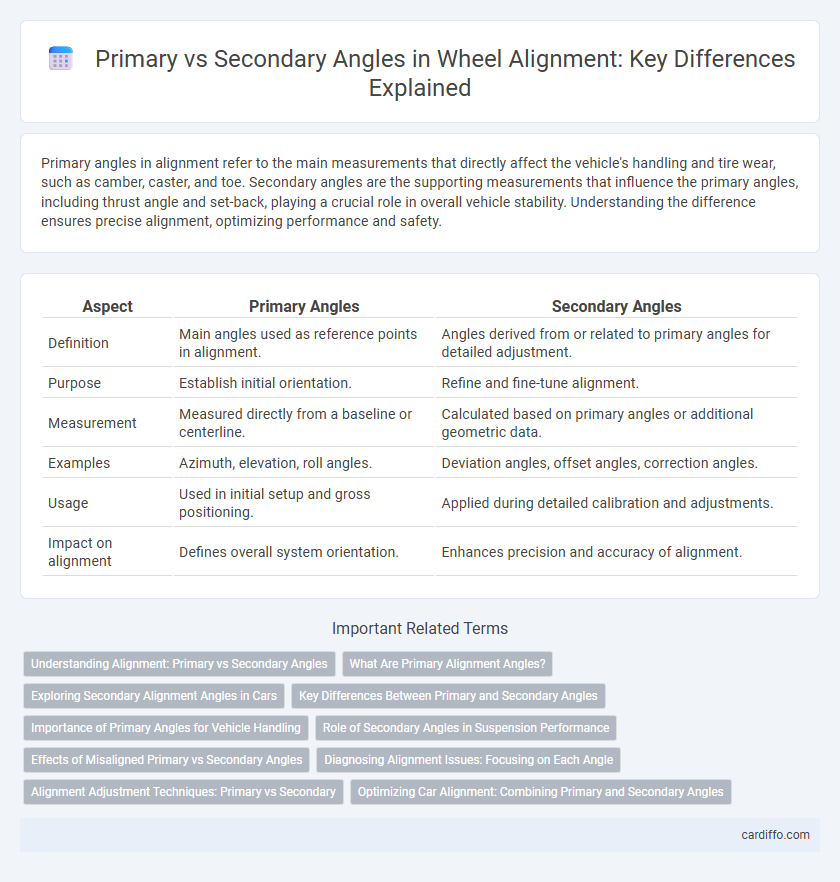Primary angles in alignment refer to the main measurements that directly affect the vehicle's handling and tire wear, such as camber, caster, and toe. Secondary angles are the supporting measurements that influence the primary angles, including thrust angle and set-back, playing a crucial role in overall vehicle stability. Understanding the difference ensures precise alignment, optimizing performance and safety.
Table of Comparison
| Aspect | Primary Angles | Secondary Angles |
|---|---|---|
| Definition | Main angles used as reference points in alignment. | Angles derived from or related to primary angles for detailed adjustment. |
| Purpose | Establish initial orientation. | Refine and fine-tune alignment. |
| Measurement | Measured directly from a baseline or centerline. | Calculated based on primary angles or additional geometric data. |
| Examples | Azimuth, elevation, roll angles. | Deviation angles, offset angles, correction angles. |
| Usage | Used in initial setup and gross positioning. | Applied during detailed calibration and adjustments. |
| Impact on alignment | Defines overall system orientation. | Enhances precision and accuracy of alignment. |
Understanding Alignment: Primary vs Secondary Angles
Primary angles in alignment refer to the main geometric relationships directly affecting vehicle handling, such as camber, caster, and toe, which ensure proper tire contact and directional stability. Secondary angles, including thrust angle and setback, influence vehicle alignment indirectly by affecting wheel positioning relative to the chassis and axle. Understanding the distinction between primary and secondary angles is essential for accurate diagnostics and achieving optimal driving performance.
What Are Primary Alignment Angles?
Primary alignment angles refer to the fundamental angles used to assess vehicle wheel alignment, specifically camber, caster, and toe. Camber measures the tilt of the wheels inward or outward when viewed from the front, caster determines the steering axis tilt for stability, and toe describes the direction the wheels point relative to the vehicle's centerline. Proper adjustment of these primary angles ensures optimal tire wear, improved handling, and enhanced vehicle safety.
Exploring Secondary Alignment Angles in Cars
Secondary alignment angles in cars, including caster angle and thrust angle, play a crucial role in vehicle handling and tire wear beyond the primary camber and toe settings. The caster angle affects steering stability and cornering performance by controlling the self-centering of the steering wheel, while the thrust angle ensures rear wheels are aligned with the vehicle's centerline to prevent tire scrubbing and improve straight-line tracking. Proper adjustment of these secondary angles optimizes overall vehicle alignment, enhances driving safety, and extends tire life.
Key Differences Between Primary and Secondary Angles
Primary angles are the original angles formed by two intersecting lines, typically used as the basis for measuring and calculating other related angles. Secondary angles, also known as supplementary or complementary angles, are derived from primary angles through mathematical relationships such as addition to 180 degrees or subtraction from 90 degrees. The key difference lies in their role: primary angles serve as the fundamental reference, while secondary angles facilitate the understanding of geometric properties and angle relationships in alignment tasks.
Importance of Primary Angles for Vehicle Handling
Primary angles such as camber, caster, and toe are critical for vehicle handling because they directly influence tire contact with the road, stability, and steering response. Properly adjusted primary angles improve traction, reduce tire wear, and ensure precise vehicle control, especially during cornering and braking. Secondary angles, while important for overall wheel alignment, primarily support the optimization of primary angles rather than determine handling characteristics.
Role of Secondary Angles in Suspension Performance
Secondary angles in vehicle suspension, such as toe and caster angles, play a crucial role in enhancing handling, stability, and tire wear by fine-tuning wheel alignment beyond primary camber adjustments. These angles optimize the contact patch and improve steering response under dynamic driving conditions, directly influencing suspension performance and ride quality. Precise adjustment of secondary angles is essential for maintaining balanced suspension geometry and maximizing overall vehicle control.
Effects of Misaligned Primary vs Secondary Angles
Misaligned primary angles, such as camber and caster, significantly impact vehicle stability, tire wear, and steering response, often leading to uneven tread wear and decreased handling precision. Secondary angles, including toe adjustments, influence vehicle tracking and tire scrub, with misalignments causing increased rolling resistance, reduced fuel efficiency, and excessive tire degradation. Accurate alignment of both primary and secondary angles is essential to optimize vehicle performance, safety, and tire longevity.
Diagnosing Alignment Issues: Focusing on Each Angle
Diagnosing alignment issues requires precise measurement of primary angles such as camber, caster, and toe, which directly influence vehicle stability, steering response, and tire wear. Secondary angles like thrust angle and included angle provide deeper insights into frame or suspension misalignment by revealing the relationship between rear and front wheel alignment. Accurate assessment of both primary and secondary angles ensures comprehensive identification of alignment deviations, enabling targeted corrections for optimal handling and tire longevity.
Alignment Adjustment Techniques: Primary vs Secondary
Primary angles include camber, caster, and toe, which directly influence vehicle handling and tire wear, making precise adjustment crucial during alignment. Secondary angles such as SAI (Steering Axis Inclination) and included angle fine-tune suspension geometry for steering stability and responsiveness but are generally fixed or adjusted less frequently. Effective alignment adjustment techniques prioritize primary angles for immediate impact on performance, while secondary angles require specialized tools and expertise to optimize subtle alignment corrections.
Optimizing Car Alignment: Combining Primary and Secondary Angles
Optimizing car alignment requires precise adjustment of both primary angles--camber, caster, and toe--and secondary angles such as thrust angle and included angle to enhance vehicle stability and tire wear. Proper calibration of primary angles ensures optimal tire contact and steering response, while fine-tuning secondary angles addresses frame or suspension irregularities, improving overall handling and safety. Integrating adjustments of these angles maximizes alignment efficiency, extending tire life and improving fuel economy.
Primary angles vs Secondary angles Infographic

 cardiffo.com
cardiffo.com